NEW: Properties of Cedar Nut Oil
Cedar nut oil is obtained from the cleaned kernel of the Siberian cedar nut by the process of cold pressing, which makes it possible to preserve the beneficial qualities of all its components. Unrefined cedar nut oil, light-yellow in colour, with a delicate nutty aroma and the highest degree of flavour, successfully competes as a delicacy with the best edible oils—olive, almond, and peanut.
The fatty acid composition of cedar nut oil incorporates a high content of mono- and polyunsaturated fatty acids (Table 1).
Table 1. Content of fatty acids in some of the most common vegetable oils (in percentage of total mass)
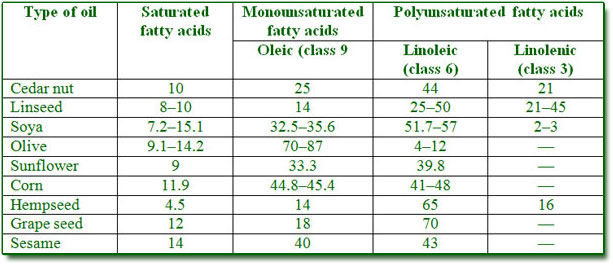
In cedar nut oil, the ratio of Omega-6/Omega-3 fatty acids is approximately 2:1. Of note is the high content of monounsaturated oleic acid, which is essential for the normal metabolism of cholesterol. The ingestion of polyunsaturated fatty acids in food requires a coincident increase in the intake of tocopherals, natural antioxidants, which protect fatty acids from free-radical oxidation. It has been determined that, for 1 gram of polyunsaturated fatty acids, 0.6 mg of tocopherols must be ingested, and moreover in the most active forms: alpha and gamma tocopherols. In cedar nut oil, this balance is observed: the content of alpha-tocopherol is 55 mg%.
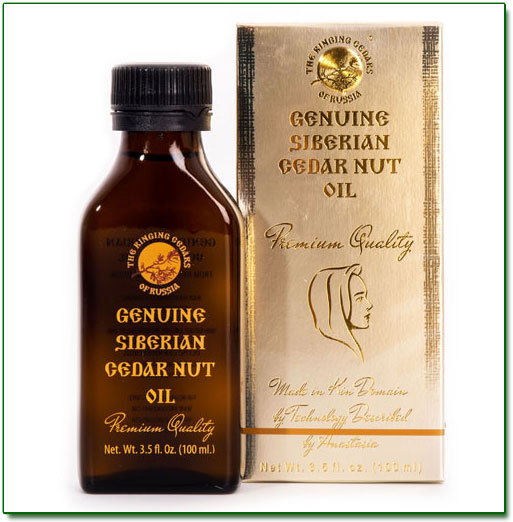
The kernel of the cedar nut contains a large quantity of phospholipids, 6.9% (1.3% in cedar nut oil), which surpasses their content in all nut and oil-yielding products. The most common phospholipids are the phosophatidylcholines (the old name was lecithins), whose composition includes glycerin, unsaturated fatty acids, and the vitamin-like substance choline, related to phosphoric acid. Phosophatidylcholine has great significance in nutrition: it facilitates the digestion, absorption, and proper metabolism of fats, increases bile secretion, normalizes the metabolism of cholesterol, and reduces the accumulation of fats in the liver. Cedar nut oil also contains phosphatidylethanolamine, phosphatidylglycerol, phosphatidylinositol, and phosphatidic acid. Of special note is the presence in cedar nut oil of cerebrosides, sulfolipids, and glycolipids, all non-specific for plants.
Unrefined vegetable oils always contain associated substances, which are extracted together with the fats, are dissolved in the fats, and influence their physico-chemical, organoleptic, and, most important, their pharmacological properties. These associated substances make up the so-called unsaponifiable fatty residue. In cedar nut oil, the associated substances are represented by pigments, phytosterols, triterpene hydrocarbons, and fat soluble vitamins.
Pigments are responsible for the colouring of natural fats, and are represented mainly by chlorophylls and carotenes. Chlorophyll, found in the oil, is also active as a medical agent. Chlorophyll has a toning action, strengthens basic metabolism, stimulates the regeneration of tissues, and has bactericidal properties. Chlorophyll—the green pigment of plants—is related in its chemical structure to the hemoglobin of human erythrocytes. This possibly explains the fact that chlorophyll ingested with food has an influence on the blood system—it promotes an increase in the quantity of leucocytes, erythrocytes, and hemoglobin.
Sterols and their esters make up the basic part of the unsaponifiable residue of oils. A distinction is made between sterols of plant origin (phytosterols) and of animal origin (zoosterols). The most common of the phytosterols is sitosterol, of the zoosterols it is cholesterol. Sitosterols, in particular the most studied of them, beta-sitosterol, exerts a hypocholesterolemic effect, reducing the absorption of cholesterol in the intestine; it demonstrates an estrogenic, antitumor, fungicidal, and bacteriostatic (stops bacterial growth and multiplication) activity. In recent years, it has been established that phytosterols may be involved in the formation of lipids in humans and animals, for example, in the membranes of erythrocytes.
Cedar nut oil contains the steroid squalene, which is an intermediate product of the biosynthesis of cholesterol.
Triterpene hydrocarbons form triterpene saponins and are constituents of the essential oil, and have bactericidal, anti-inflammatory, and expectorant effects.
Cedar nut oil is a rich source of fat-soluble vitamins and several group B vitamins (Table 2)
Table 2. Vitamin content of cedar nut oil

Vitamin A in vegetable products is contained in the form of provitamins—beta-carotene and other carotinoids. Vitamin A regulates metabolic processes in the body; participates in the processes of tissue respiration and energy metabolism; influences the permeability of cell membranes; is essential for tissue growth, development and differentiation; influences the functioning of the endocrine glands (adrenal glands, reproductive glands); is responsible for the normal condition of the skin, mucous membranes of the eyes, the gastrointestinal tract, and the respiratory and urinary tracts; increases the resistance of the body to respiratory infections; and exerts a specific influence on the functioning of vision (serves as a cofactor of rhodopsin—visual purple—responsible for the perception of light). A deficiency of vitamin A leads to the development of lesions on the integument and mucous membranes, and a significant weakening of vision. Until recently it was considered that the basic function of carotinoids in the body was their transformation into vitamin A. Research in recent years has demonstrated that the carotinoids themselves play an important role in metabolic processes, especially as antioxidants. Beta-carotinoids are assimilated better in the presence of the trace elements zinc, selenium, the amino acids cysteine and glutathione, bile acids, and exogenous antioxidants, such as the bioflavonoids, gallocatechols, and anthocyanidins.
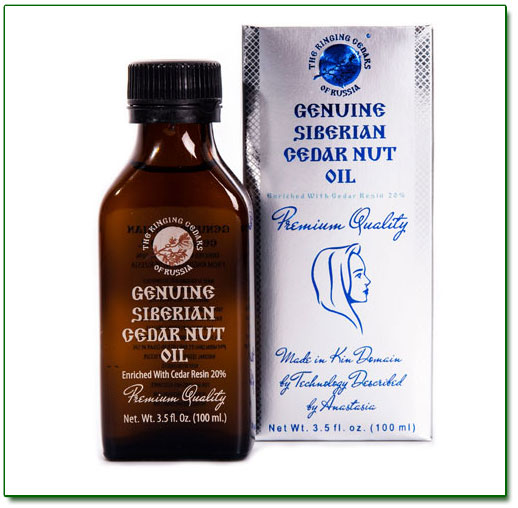
Vitamin E (tocopherol). Tocopherol's mechanism of action is related to its involvement in the maintenance of the stability of cell membranes and cellular organelles through its antioxidant properties—the ability to impede the peroxide oxidation of polyunsaturated fatty acids. The requirement of vitamin E is directly proportional to the intake of polyunsaturated fatty acids into the body. A deficiency of vitamin E leads to the development of the dystrophy of the skeletal muscles and cardiac muscle, an increase in the brittleness of capillaries, the breakdown of erythrocytes, the disruption of reproductive functioning, and the development of degenerative changes in nerve cells and liver cells. A vitamin E deficit lowers the level of magnesium in the tissues; selenium and vitamin E are better assimilated together.
Vitamin D regulates the metabolism of calcium and phosphorus, ensures the absorption of these substances in the intestine and their deposit in growing bone, thus ensuring the strength of the bones and teeth. Vitamin D aids the assimilation of magnesium, which is also essential for the development of bone tissue. Vitamin D has an influence on the permeability of cellular and intracellular membranes to calcium ions. It is synthesized in the body as a result of the action of sunlight on the skin. The formation of the biologically active form of the vitamin occurs in the liver and kidneys. Vitamin D insufficiency is widespread among young children, and plays a significant role in the development of rickets. In adults, hypovitaminosis D occurs rarely, and manifests itself in the form of osteoporosis. Vitamin D is toxic; in the event of excessive use of concentrated preparations, it is possible to develop hypervitaminosis, so it is important that its intake into the body be in natural form, with food products.
Vitamin B1 (thiamine) is involved in the metabolism of carbohydrates, proteins, and fats; it provides for normal growth; it increases the motor and secretory activity of the stomach; and it normalizes the work of the heart. In the body, thiamine is transformed into the coenzyme cocarboxylase. Thiamine is essential for the synthesis of that most important neurotransmitter, acetylcholine. An insufficiency of thiamine may develop in cases of alcohol abuse, with an excess of refined carbohydrates in the diet, in diseases of the gastrointestinal tract, as a consequence of a disruption of the absorption of this vitamin, and during the use of antibiotics. The basic manifestations of hypervitaminosis B1 is polyneuritis and disruptions of the activity of the heart and gastrointestinal tract.
Vitamin B2 (riboflavin) affects the growth and development of the fetus and the child; it plays an important role in the metabolism of carbohydrates, fats, and proteins; it plays an important role in maintaining vision, participates in the formation of rhodopsin, visual purple, protecting the retina against excessive exposure to ultraviolet radiation; it is involved in the synthesis of hemoglobin. The biochemical mechanism of the action of riboflavin is related to its involvement in the processes of biological oxidation and energy metabolism. In avitaminosis B2, the eyes are affected (inflammation of the cornea, clouding of the crystalline lens) as well as the mucous membrane of the oral cavity. A synergism has been discovered between riboflavin and vitamin B6, zinc, and selenium.
Vitamin PP (niacin, nicotinic acid) participates in reactions involved in cellular respiration and intermediate metabolism, since it is a constituent of the enzymes that carry out reduction-oxidation reactions; it improves carbohydrate metabolism, has a positive action in less severe forms of sugar diabetes; it reduces the level of cholesterol in the blood; it normalizes the secretory and motor functions of the gastrointestinal tract, and has a positive effect on peptic ulcers of the stomach; it has a vasodilator effect. Cases of avitaminosis lead to pellagra ("rough skin"), which is characterized by dermatitis (inflammation of the skin), disruption of the functions of the gastrointestinal tract, lesions on the mucosa of the oral cavity, and disturbances of the mental state. Niacin is formed in the body from the amino acid tryptophan; 60 mg of tryptophan forms 1 mg of niacin.
Table 3. Macroelement and trace-element composition of cedar nut oil
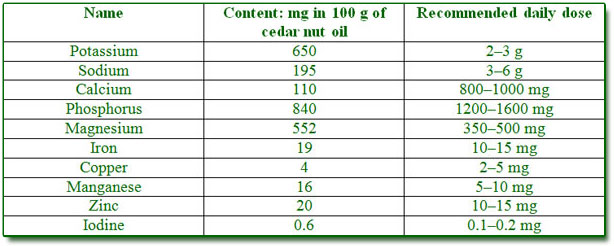
Nutritionally significant is the content of phosphorus, magnesium, manganese, copper, zinc, and iodine. The presence of the listed macroelements and trace elements classifies the cedar nut kernel as a natural source of the minerals that play an important role in many biochemical processes in the human body.
Cedar nut oil contains nitrogen compounds, represented mainly by free amino acids. Among these are all the essential amino acids—valine, isoleucine, leucine, lysine, methionine, threonine, tryptophan, and phenylaline—and the interchangeable amino acids—arginine, histidine, tyrosine, alanine, glycine, proline, serine, aspargine, glutamine.
The importance of amino acids for the body lies above all in the fact that they are used for the synthesis of proteins. In addition, amino acids are the basis for the formation of a large quantity of nonpeptides that perform special functions. These include choline (a constituent of phospholipids), taurine (involved in the metabolism of bile acids), and heme (a component of hemoglobin). The amino acid tyrosine is the precursor of the thyroid gland hormones and the catecholamines—adrenaline and noradrenaline—and is a constituent of the dark-coloured melanin pigments that determine skin and hair colour. Melanins are also found in the pigmented layer of the retina. Histidine is the basis for the formation of the biogenic amine, histamine, which plays the role of a local hormone. A small quantity of vitamin PP (niacin) is synthesized in the body from tryptophan. In addition, tryptophan is the precursor of the neurotransmitter serotonin, on which depends the emotional state of the individual; an insufficiency of serotonin is characteristic of depressive conditions.
Some amino acids themselves are biologically active. The amino acid lysine increases the nonspecific resistance of the body, has an influence on the tone of the cardiac vessels, and reduces the level of cholesterol in the blood. Methionine inhibits the deposit of excess fat in the liver, protects liver cells from the effect of toxic substances, and participates in the synthesis of phosphatidylcholine. The amino acids alanine and glycine play the role of inhibitory transmitters in the brain, while glutamic acid and aspartic acid are excitatory transmitters. The amino acid arginine increases the nonspecific resistance of the body, eases spasms of blood vessels, reduces the level of cholesterol in the blood, and is an essential amino acid in the growth period of children. The sulfur-containing amino acid cysteine is a natural antioxidant.
RingingCedarsofRussia.org
* * *
Customer Reviews:
For the first three weeks of taking 1 tablespoon/day cedar nut oil, everything tasted different. After the first three wks of use, I feel better, no longer have heartburn, many aches/pains have vanished and I have more energy. The flavor is mild too.
Connie Voss, USA
* * *
I have used your Cedar Nut oil for my acidity and ulcer. I was taking 2 tbls, 30 min before my breakfast and lunch for my ulcer treatment, as your representative recommended. and I felt tremendous relief after taking it for about 1 week. I love its pleasant color and taste.
Alina Wallace, USA
* * *
I have used this product and I am very impressed with the results. Thank you for your products.
I would like to market cedar nut oil to the people who need them and make it available to all who seek its natural healing powers. Will you allow me to sell these products on a national level here in the US ? ... I did see a doctor before using the cedar nut oil and after 30 days of using the oil I had improved so much in my liver function testing that the doctor released me from care and told me to keep doing whatever it is that I am doing because it is working.
Thank you,
Richard Jacobson, USA
Click here to go to our online store

Cedar Nut Flakes "Pine Power"
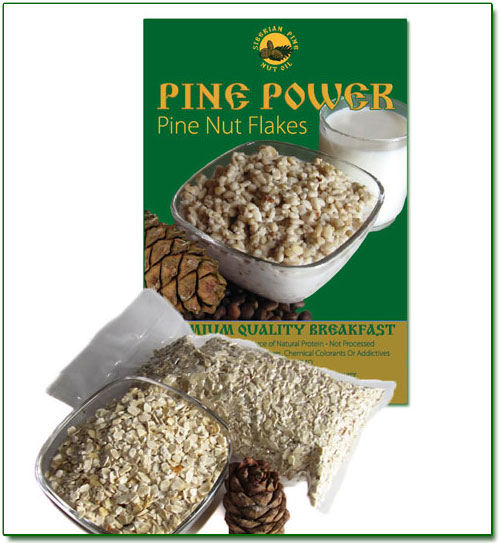
The flakes of the cedar nut are obtained by pressing the cedar nut oil from the kernel of the cedar nut. In contrast to the whole cedar nut, cedar nut flakes are distinguished by their increased proportional content of vitamins, trace elements, and plant proteins owing to the reduction of the fat content. In the processing of pressing the cedar nut oil, 10–16% of the cedar nut oil is retained in the flakes.
The protein in the flakes made from the kernel of the cedar nut surpasses an ideal protein in its content of histidine, methionine, cysteine, and tryptophan, and has a well balanced composition. The carbohydrate composition of the kernel of the cedar nut is represented by polysaccharides (starch, cellulose, pentosans, dextrins) and water-soluble sugars (glucose, fructose, sucrose, and raffinose). According to the results of medical research, a similar protein facilitates the dissolving of harmful cholesterol in the blood, and also prevents the formation of cancer cells.
The lecithin contained in cedar nut flakes is a basic chemical substance for the formation of the intercellular space, the normal functioning of the nervous system, and the healthy activity of brain cells. Lecithin is essential for the organism as a building material for the renewal of damaged cells. Lecithin is also the basic transport substance for the delivery of nutrients to the cells. Lecithin makes up 50% of the liver, 1/3 of the myelin insulating and protective tissues that surround the cerebrum and spinal cord. Lecithin is a powerful antioxidant and prevents the formation of highly toxic free radicals in the organism.
Flakes made from the kernel of the Siberian cedar contain a high quantity of mineral substances—up to 5%, which are represented by a specific set of macroelements and trace elements. There is a high content of phosphorus and magnesium. Only 100 g of cedar nut contains the human daily requirement of magnesium, manganese, copper, zinc, and cobalt. Of special interest is the cedar nut as a natural source of iodine. The daily requirement of iodine is 0.1–0.2 mg, and the cedar nut kernel contains on average 0.577 mg/kg of iodine.
The importance of the flakes with regard to vitamins is characterized by the presence of fat-soluble and water-soluble vitamins, the most basic of which are vitamin F, the tocopherols, thiamine, and riboflavin.
The use of cedar nut flakes is recommended:
- for ulcerous conditions of the stomach and duodenum;
- in increased acidity and gastritis;
- in pulmonary diseases and tuberculosis;
- in nervous disorders;
- in diseases of the kidneys;
- in diseases of the thyroid gland related to an insufficiency of iodine;
- in blood and lymph diseases;
- in malnutrition and emaciation.
|
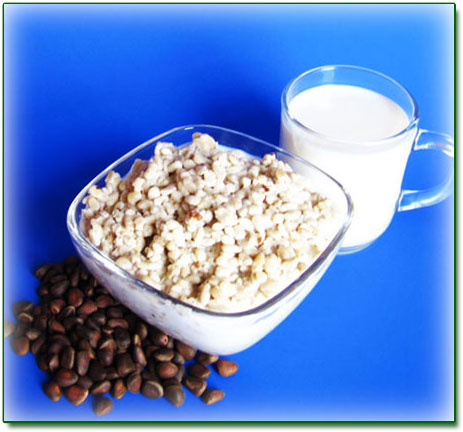
Cedar nut flakes should definitely be present in the food allowance of pregnant women, children, and breast-feeding mothers (for lactation). In olden times, when milk was completely absent, children were fed with a mixture prepared from cedar nut flour.
Cedar nut flakes are natural protein, and are extremely suitable for athletes to increase muscle mass.
The flakes have a pleasant nutty taste and aroma, are easily digested, and can include particles of the membrane of the cedar nut pericarp, which is rich in potassium.
Directions for use:
Cedar nut flakes are used as a complement to food (in porridge, salads), as part of flour-based confectionaries, as well as a separate food product. The consumption of 3–5 tablespoons of flakes a day fully provides the organism with essential components.
Cooking Instructions:
1. Fill the bowl with pine nut flakes.
2. Blend your flakes with honey and/or fresh or dry fruits (for example, banana slices, strawberries, kiwi fruit, peach slices etc.)
3. Add warm milk just to cover ingredients and stir. Add more milk if the mix seems too thick and stir again. Instead of milk you can add juice, maple syrup, kefir or yogurt.
4. Depending on the type of liquid you use, you may wish to leave pine nut flakes for 10-15 minutes to mesh well with it.

Recipes
1. Cedar Nut Flakes Salad. In a large bowl mix together 1/2 pound romaine lettuce, 1/2 pound quartered cherry tomatoes, 1/2 pound sliced cucumbers, 1/3 cup cedar nut flakes and 1/8 cup finely chopped fresh basil. Pour 3-4 tbsp cedar nut oil and squeeze 1/2 lemon. Add salt to taste and toss well.
2. Tahini Sauce. Mix together 2 tbsp raw tahini, 1/2 juiced Lemon, 1tbsp Honey, 2 pressed garlic cloves and 2 tbsp cedar nut flakes. This sauce goes deliciously with crackers.
3. Protein Milk. Makes: 4-7 cups. Combine 1 cup cedar nut flakes and 3-5 cups water in a blender. You can create the desired thickness by using more or less water. Blend on high for 4-5 minutes. To sweeten add honey, bananas, dates, figs, raisins, maple syrup or your favorite fruit. Blend again until smooth. You can enjoy it thick or strain it through cheesecloth. Protein milk is perfect alone and with your meal. It will keep for 2 days in the refrigerator in a sealed glass container.
http://www.RingingCedarsofRussia.org/
Used by permission
Copyright CedarInfo.info
* * *
What People Say About This Product:
I am on an elimination diet to regain better health, having a damaged immune system and digestion. Since I cannot have any grains, the Pine Power Pine Nut Flakes have been a godsend for breakfast (you can eat only so many greens in a day!). I make them with hot water, letting steep while I drink my tea, and love the nutty taste in the morning. Thanks! Looking forward to trying the recipes.
Debor Austin, TX, USA
* * *
I am not the type who likes cedar nuts, but these flakes are delicious! These have a soft taste and are great in smoothies. Gives a wonderful consistency to them! I decided to try them since I am vegetarian and need variety with my proteins. Great option.
Pat Garcia, Montreal, Canada
* * *
The cedar nut flakes are very nutritional! The first time I put a bowl of them with milk and felt full after eating just half of it. I add few table spoons in my other cereals and salads every day and I love their delicate taste.
Thanks,
Brian Rozine, Sydney, Australia
Click here to go to our online store

Our Unique Production Technique:
| |
Cedar Nut Sheller
This equipment and method of shelling Siberian Cedar Nuts brings the difference in the quality of "RINGING CEDARS OF RUSSIA" Siberian Cedar Kernels and Siberian Cedar Nut Oil
|
| |
Cedar Nut Oil Press
This equipment and method of pressing Siberian Cedar Nuts brings the difference in the quality of "RINGING CEDARS OF RUSSIA" Siberian Cedare Nut Oil
|
The brand name "THE RINGING CEDARS OF RUSSIA" stands for business integrity, decency and the highest possible quality of product. All products marketed under this brand name convey the primordial power of Nature and the warmth of our hearts. We offer:
A variety of high-quality cedar products, including cedar nuts and cedar nut oil.
Huge plantations of cedar trees grow in the Siberian taiga, said to be the ecologically purest area of the world. The virgin forest of the taiga has never been treated with any chemicals or artificial fertilisation, nor abused by agricultural machines.
Cedar nuts (the seeds of the cedar tree) take two years to mature, during which time the tree accumulates a huge volume of positive cosmic energy. Crops of nuts are harvested manually by people lovingly devoted to this task, working in a pleasant environment without undue haste to create unique products full of positive energy reflecting the infinite powers of Nature. Specific preparations include:
We pick only cedar cones which fall naturally from the trees, thus ensuring that only ripe cones are selected. We always avoid hitting the trees to shake unripe cedar cones down (as happens with some other commercial operations) -- a practice which causes the nuts to lose their healing power.
Cones are then manually shelled with the help of wooden shell-removers. Nut centres are separated from their shells using wooden rollers.
Cedar nut oil and cedar nut flour marketed under our brand name are obtained by the cold-pressure method, using manual wooden oil-presses.
Cedar nut oil is then stored in special containers and packed in a Kin Domain "Sunny Meadow" located near Tomsk city using unique technology to avoid any contact with metal. The whole process is strictly supervised to ensure it complies with all sanitary requirements.
Final products are placed in special packaging to prevent daylight penetration, and stored at a temperature of 0C to +5C to better preserve the product's natural components. The resulting product is a bright gold-coloured liquid with the pleasant smell of cedar nuts. It is a 100% natural product with strong healing powers.
SIBERIAN CEDAR NUT OIL
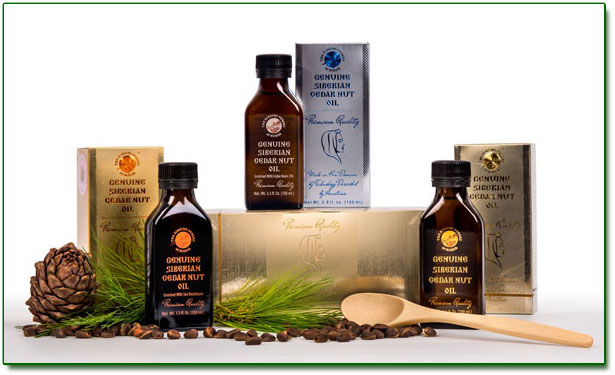
Siberian Cedar nuts (cedar nuts) contain about 60% oil. They are therefore pressed to obtain Cedar nut oil, which is available on the market as a very expensive gourmet cooking oil. Cold pressing in all-wooden presses is preferred to retain the nutritional properties of nuts and derive the oil of highest quality.
The Cedar nut oil bearing "The Ringing Cedars of Russia" brand comes exclusively from wild-harvested Siberian Cedar nuts - one of the most nutritious Cedar nuts in the world. In comparison, other Cedar nut oils are usually pressed from the Italian pignolia Cedar nuts, which are not nearly as potent and are often harvested from trees growing in plantations. Our Siberian Cedar nut oil is extra virgin (100% cold pressed from freshly shelled raw Siberian Cedar nuts), whereas most Cedar nut oils on the market are either not cold pressed or even pressed from roasted (!) Cedar nuts, which significantly decreases the oil value. Finally, "The Ringing Cedars of Russia" Siberian Cedar nut oil is the only one which is available on the market anywhere in the world pressed with wooden presses in accordance with traditional techniques described in Vladimir Megre's life-changing book "The Ringing Cedars of Russia". In contrast, all other Cedar nut oils are pressed using steel presses, which immediately degrades them (contact with steel oxidizes some of the Cedar nut oil's most important ingredients such as vitamins, and is known to remove the 'life force' from the oil).
Cedar nut oil has also traditionally been used in ancient Russian and European natural medicine to cure a wide array of ailments - ingested (decreasing blood pressure, boosting immune system resistance, etc.) or applied externally (a range of dermatological disorders). It is also used in expensive cosmetics.
Cedar nut oil contains pinolenic acid, a polyunsaturated fatty acid, and is marketed in the U.S. as a means stimulate cell proliferation, prevent hypertension, decrease blood lipid and blood sugar, and inhibit allergic reactions.
Copyright: http://www.RingingCedarsOfRussia.org/


PEARLED BARLEY SALAD WITH APPLES, POMEGRANATE SEEDS, AND CEDAR NUTS
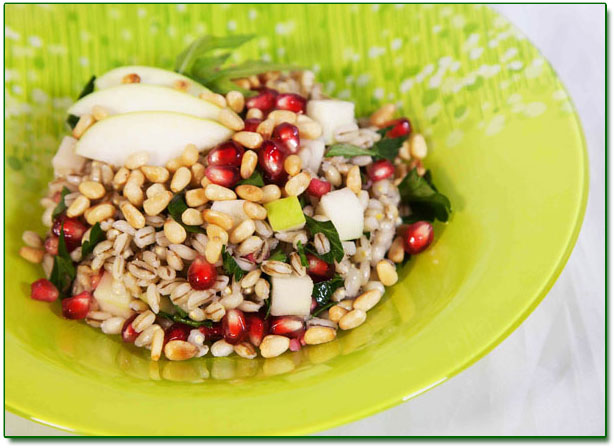
Ingredients:
1/3 cup(s) (2 ounces) cedar nuts
1/4 cup(s) extra-virgin cedar nut oil
2 tablespoon(s) extra-virgin cedar nut oil
3 tablespoon(s) white wine vinegar
1 small (2 tablespoons) shallot, minced
Salt, Freshly ground pepper
4 cup(s) Thyme-Scented Pearled Barley
1 large tart apple, such as Honeycrisp, cored and cut into 1/2-inch pieces
1/2 cup(s) (from 1 pomegranate) pomegranate seeds
1/2 cup(s) chopped flat-leaf parsley
Preparation:
1. Preheat the oven to 350 degrees F. Spread the cedar nuts in a pie plate and toast until golden, about 5 minutes. Let cool.
2. In a bowl, whisk the oil with the vinegar and shallot and season with salt and pepper. Add the Thyme-Scented Pearled Barley, cedar nuts, apple, pomegranate seeds, and parsley; toss before serving.
PARSLEY LEMON AND CEDAR NUT LINGUINE
Ingredients:
4 tbsp freshly chopped Flat Leaf Parsley
120ml/4fl.oz extra virgin Cedar Nut Oil
The grated Zest of 2 Lemons
2 tbsp Cedar Nuts, toasted
450g/1lb Linguine
Salt and Freshly ground Black Pepper
1 Lemon, cut into 4 wedges
Preparation:
1. Place the parsley, oil, lemon zest, and cedar nuts in a large mixing bowl and mix well. Season with salt, cover with clingfilm and leave for at least 2 hours at room temperature, mixing a couple of times during the period.
2. When ready to serve, bring a large saucepan of water to the boil.
3. Add plenty of salt then add the linguine, bring to the boil, reduce the heat and cook for 8-10 minutes.
4. Drain the pasta, reserving about 120ml/4fl.oz. of the cooking water.
5. Add the hot pasta and reserved cooking water to the parsley mixture and toss until the pasta is well coated. Season with pepper, toss again and serve immediately garnished with the lemon wedges.
Serves 4
CHERRY CEDAR NUT BISCOTTI
Ingredients:
2 large Eggs
1/2 teasp Vanilla Extract
100g/4oz Sugar
225g/8oz Self Raising Flour
75g/3oz Cedar Nuts
25g/1oz Glace Cherries, chopped
Preparation:
1. Preheat the oven to 190C, 375F, Gas Mark 5 and line a baking sheet with parchment or greaseproof paper.
2. Place the eggs in a large bowl, beat well then add the sugar and mix well.
3. Stir the lour into egg mixture, beat with a wooden spoon to combine then mix in the nuts and cherries until well incorporated.
4. Divide the dough in two, transfer to a well floured work surface and shape each half into a long log about 7.5cm/ 2 1/2 inch wide. Place them well spaced apart on the baking sheet and smooth the tops and sides with a rubber spatula. Bake for 30 minutes.
5. Remove from the oven and allow to cool for a few minutes. Reduce the oven temperature to 150C, 300F, Gas Mark 2.
6. Slide the logs onto a cutting board. With a large serrated knife, cut each log diagonally into 12mm/ 1/2 inch slices. Place the slices cut sides down on the baking tray and return to the oven for 10 minutes.
7. After 10 minutes, turn the biscotti over and bake for a further 10 minutes.
Makes approx 24
http://www.delish.com/; http://www.recipes4us.co.uk/
CEDAR NUTS CAN BE SUBSTITUTED WITH CEDAR NUT FLAKES.
Pair pasta-like potato gnocchi with wilted spinach for a light and flavorful dish in minutes.
Ingredients:
1 (16-ounce) package vacuum-packed gnocchi (such as Vigo)
2 tablespoons butter
2 tablespoons cedar nuts
2 garlic cloves, minced
1 (10-ounce) package fresh spinach, torn
1/4 teaspoon salt
1/4 teaspoon freshly ground black pepper
1/4 cup (1 ounce) finely shredded Parmesan cheese
Preparation:
1. Cook gnocchi according to package directions, omitting salt and fat; drain.
2. Heat butter in a large nonstick skillet over medium heat. Add cedar nuts to pan; cook 3 minutes or until butter and nuts are lightly browned, stirring constantly. Add garlic to pan; cook 1 minute. Add gnocchi and spinach to pan; cook 1 minute or until spinach wilts, stirring constantly. Stir in salt and pepper. Sprinkle with Parmesan cheese.
Servings: 4
http://www.browneyedbaker.com/
http://www.myrecipes.com/
http://vegangela.com/
CEDAR NUTS CAN BE SUBSTITUTED WITH CEDAR NUT FLAKES.
For more recipes please click here

For Educational purposes only
This information has not been evaluated by the Food and Drug Administration.
This information is not intended to diagnose, treat, cure, or prevent any disease.
These articles come directly from researchers and are passed on to everybody. The company assumes no liability for any content in these articles.
For more great articles go to http://www.ringingcedarsofrussia.org/cedar_nuts_and_ringing_cedars_information.php